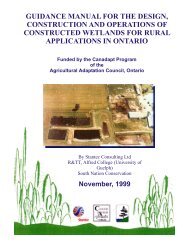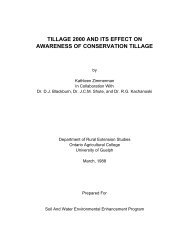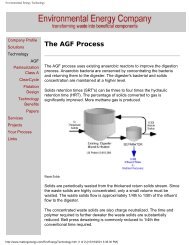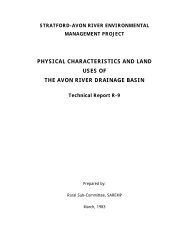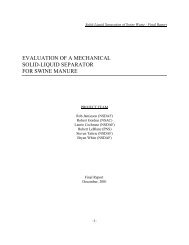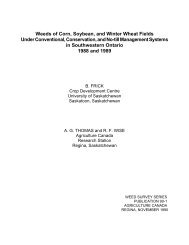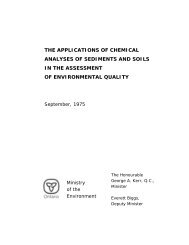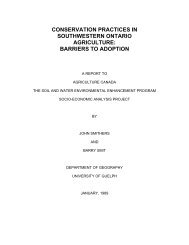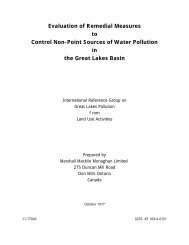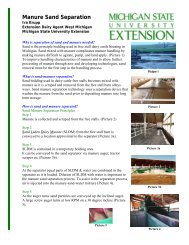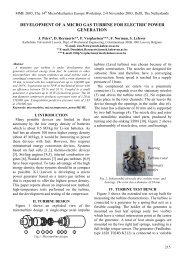Environmental Aspects of Phosphate and Potash Mining United ...
Environmental Aspects of Phosphate and Potash Mining United ...
Environmental Aspects of Phosphate and Potash Mining United ...
You also want an ePaper? Increase the reach of your titles
YUMPU automatically turns print PDFs into web optimized ePapers that Google loves.
The <strong>Environmental</strong> Approach <strong>of</strong> the <strong>Phosphate</strong> Rock <strong>and</strong> <strong>Potash</strong> <strong>Mining</strong> Industry<br />
26<br />
Air Emission Control By-Products<br />
Zirconium is recovered as a co-product during phosphate<br />
rock processing at the Phalaborwa operation <strong>of</strong><br />
Foskor Limited in South Africa.<br />
Dust emissions from the zirconium plant prompted<br />
the installation <strong>of</strong> an emission control system. Fine silica<br />
fume generated during processing is recovered by<br />
the system <strong>and</strong> subsequently sold, producing a revenue<br />
stream. The revenue generated has resulted in<br />
the rapid payback <strong>of</strong> the installation costs for the air<br />
emission control system.<br />
The system has produced environmental benefits<br />
from the reduction in dust emissions as well as an<br />
additional revenue stream for the company.<br />
The problem <strong>of</strong> dust emissions may be compounded<br />
by processes such as calcination <strong>and</strong> drying, which<br />
generate high levels <strong>of</strong> exhaust particulates <strong>and</strong> gases.<br />
These emissions are reduced through the use <strong>of</strong> cleaner<br />
fuels such as natural gas, applying emission control<br />
equipment to exhausts, using more efficient equipment<br />
<strong>and</strong> making use <strong>of</strong> cogeneration possibilities <strong>and</strong><br />
heat recovery. In some cases, minor adjustments have<br />
improved the efficiency <strong>of</strong> old equipment.<br />
Steam-Heated Fluidized Bed Dryers for <strong>Potash</strong> Ore<br />
The installation <strong>of</strong> steam-heated fluidized bed dryers<br />
to dry potassium chloride at the Hattorf operation <strong>of</strong><br />
Kali und Salz GmbH in Germany has resulted in 35%<br />
less energy consumption, with markedly lower flue<br />
gas <strong>and</strong> dust emissions in comparison to rotary dryers.<br />
Exhaust emissions from vehicle engines, electrical<br />
power generation <strong>and</strong> product dryers may contain<br />
greenhouse gases such as carbon dioxide (CO 2 ) <strong>and</strong><br />
other gases such as NO x . The use <strong>of</strong> improved fuel or<br />
energy consumption techniques <strong>and</strong> technologies<br />
reduces the emission <strong>of</strong> greenhouse gases <strong>and</strong> other<br />
exhaust particulates <strong>and</strong> gases.<br />
Dryer Burner Modifications<br />
The IMC <strong>Potash</strong> Carlsbad operation in New Mexico<br />
(USA) has significantly reduced the exhaust emissions<br />
from an aging product dryer through minor modifications.<br />
A small adjustment to the angle <strong>of</strong> the burner<br />
fuel injection nozzles created more turbulent flow<br />
conditions, improving the mixing <strong>of</strong> fuel <strong>and</strong> air <strong>and</strong><br />
hence, the combustion.<br />
The result has been greater fuel efficiency <strong>and</strong> a significant<br />
reduction in the quantity <strong>of</strong> carbon<br />
monoxide.<br />
Noise <strong>and</strong> Vibration<br />
Beneficiation processes may generate high levels <strong>of</strong><br />
noise <strong>and</strong> vibration, especially during crushing <strong>and</strong><br />
grinding. Noise pollution has been reduced in many<br />
cases by enclosing the plant, retaining suitable buffer<br />
zones around the plant site, planting greenbelts <strong>and</strong><br />
constructing earth bunds. Some <strong>of</strong> these measures<br />
also assist in reducing the visual impact <strong>of</strong> the site.<br />
Resource Maximization<br />
The efficiency <strong>of</strong> resource recovery influences the<br />
environmental impact <strong>of</strong> other activities such as<br />
extraction or waste disposal.<br />
Product loss during beneficiation through the loss <strong>of</strong><br />
ore to waste streams, dust emissions <strong>and</strong> process<br />
spillages results in both an economic loss as well as the<br />
need to extract <strong>and</strong> process additional ore to meet<br />
dem<strong>and</strong>. An example <strong>of</strong> this is the fine particles <strong>of</strong><br />
phosphate that are lost to waste, as they cannot be efficiently<br />
separated.<br />
Ultra-Fine <strong>Phosphate</strong> Recovery<br />
In Brazil, the Tapira mining complex <strong>and</strong> Uberaba fertilizer<br />
complex operated by Fertilizantes Fosfatados<br />
SA (Fosfertil) are exp<strong>and</strong>ing production. A component<br />
<strong>of</strong> this is the implementation <strong>of</strong> a process to recover<br />
the ultra-fine phosphate previously lost to the clay<br />
tailings. The system will use column flotation cells to<br />
recover around 200,000 tonnes <strong>of</strong> ultra-fine phosphate<br />
rock per year. This ultra-fine product will be<br />
used to produce single super-phosphate (SSP) fertilizer.<br />
Recovery <strong>of</strong> the ultra-fine phosphate rock has provided<br />
an additional source <strong>of</strong> revenue for the company,<br />
enhancing its competitiveness in the market place.<br />
<strong>Environmental</strong> benefits are derived from greater<br />
recovery <strong>of</strong> the resource <strong>and</strong> consequently, a minor<br />
reduction in the waste volume generated.<br />
Spillage <strong>of</strong> ore <strong>and</strong> concentrated product may occur<br />
during beneficiation, prevention or recovery <strong>of</strong> these<br />
can assist maximizing the resource.<br />
Product Spillage Recovery<br />
In South Africa, Foskor has been using h<strong>and</strong> shovels<br />
<strong>and</strong> wheelbarrows to recover small amounts <strong>of</strong><br />
spillage associated with the loading <strong>of</strong> phosphate<br />
rock concentrate into rail cars. Approximately 20,000<br />
tonnes <strong>of</strong> product were recovered in one year providing<br />
a significant saving.



